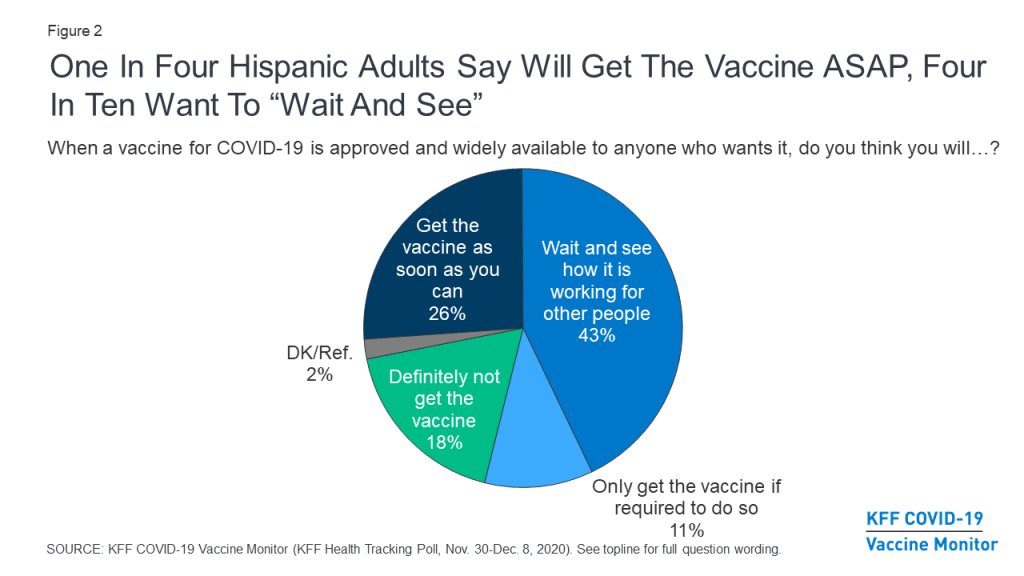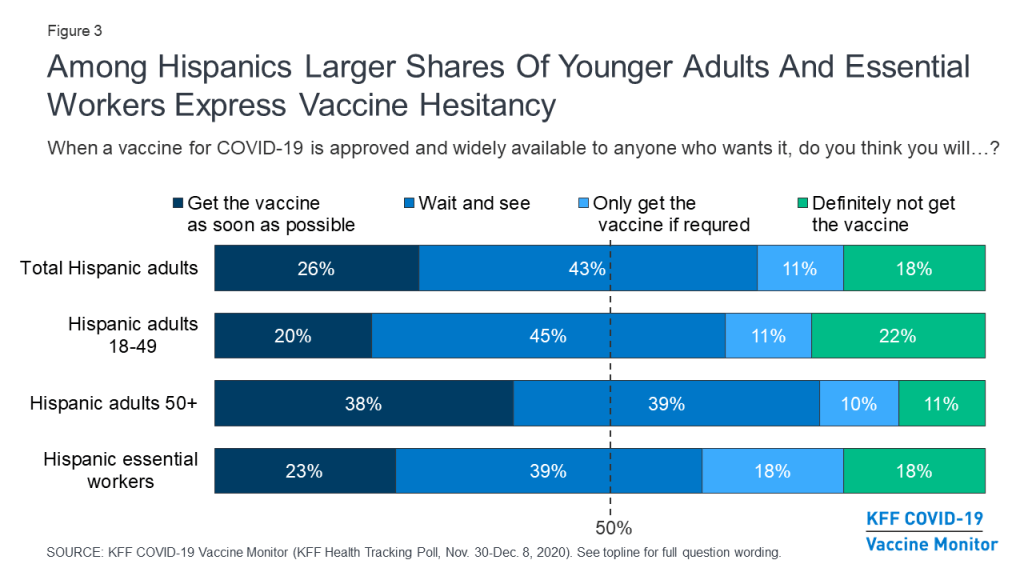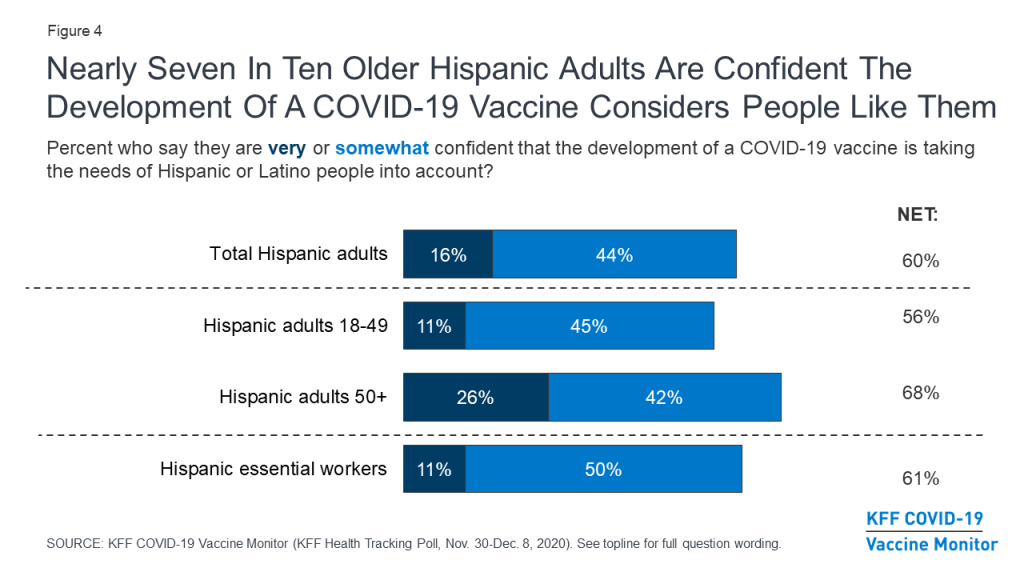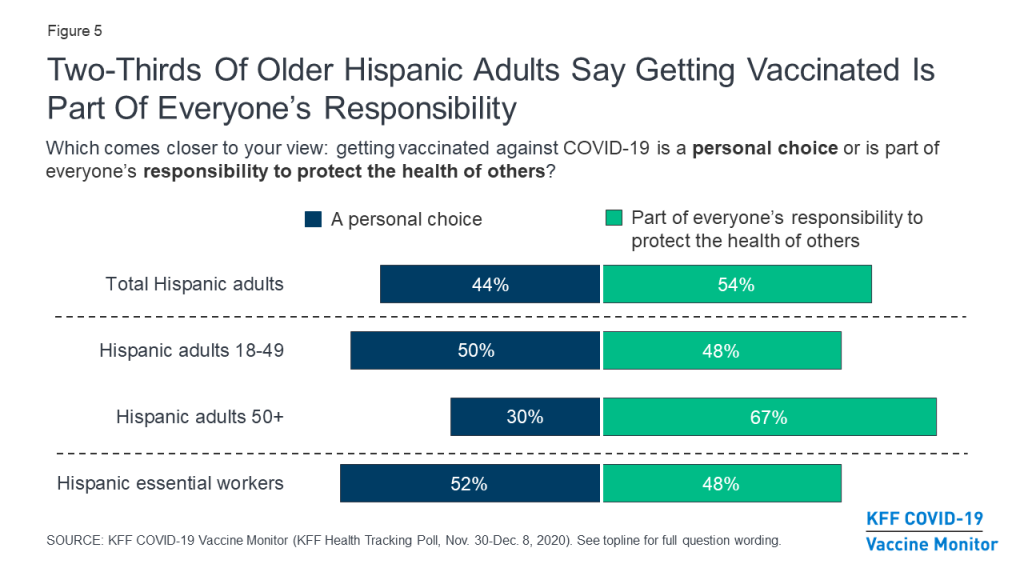Vaccine Hesitancy Among Hispanic Adults
Findings
The KFF COVID-19 Vaccine Monitor is an ongoing research project tracking the public’s attitudes and experiences with COVID-19 vaccinations. Using a combination of surveys and focus groups, this project will track the dynamic nature of public opinion as vaccine development unfolds, including vaccine confidence and hesitancy, trusted messengers and messages, as well as the public’s experiences with vaccination as distribution begins.
Vaccine Hesitancy Among Hispanic Adults
The COVID-19 pandemic has had a disproportionate impact on people of color. A previous KFF analysis found that along with Black and American Indian and Alaska Native (AIAN) people, Hispanic people were overrepresented in coronavirus cases and more likely to suffer worse outcomes than their White counterparts. Moreover, Hispanic adults have been harder hit by the economic impact of the pandemic as the December 2020 KFF COVID-19 Vaccine Monitor poll finds half (52%) of Hispanic adults say their household has lost a job or income since the coronavirus began spreading in the U.S. in February 2020 –compared to fewer White adults (42%) who say the same. With the risk of coronavirus ever present, four in ten Hispanic adults (43%) say they are essential workers required to work outside their home during the coronavirus outbreak (78% of all employed Hispanic adults compared to six in ten employed White and Black adults). With Hispanic adults being among the groups most impacted by the pandemic, the KFF COVID-19 Vaccine Monitor finds that while most Hispanics are open to getting vaccinated, there remains a sizeable share, particularly among younger Hispanics, who express at least some vaccine hesitancy. Communication efforts focused on reaching Hispanics will need to take this and other heterogeneity into account. This analysis seeks to shed light on what we know so far about vaccine hesitancy among Hispanic adults and the messages and trusted messengers that might succeed at ensuring a robust vaccination effort for this key group.
Most Hispanic adults indicate they are likely to get the COVID-19 vaccine with seven in ten (71%) saying they will “definitely get” the vaccine (36%) or “probably get it” (35%). While a similar share of White adults (73%) say they will probably or definitely get the vaccine, Hispanic adults are less likely than their White counterparts to say they “definitely” will get it (36% vs. 46%). About one in four Hispanic adults say they will “probably not get it” (8%) or “definitely not get it” (18%).

One in four Hispanic adults (26%) report being the most enthusiastic to get the vaccine saying they will get the COVID-19 vaccine “as soon as possible,” an additional four in ten (43%) say they will “wait and see” how it is working for others before getting the vaccine. One in ten (11%) say they will only get the vaccine if they are required to do so for work or other activities and 18% of Hispanic adults say they “will definitely not” get the vaccine, similar to the share of White and Black adults who say they definitely will not get the vaccine (15% each). While a majority of Hispanic adults indicate they are open to getting the vaccine, a smaller share of Hispanic adults compared to White adults express enthusiasm of wanting to get the vaccine as soon as possible (26% vs. 40%).

Among Hispanic adults, differences across age groups are more pronounced than those across gender, education, and income levels. Mirroring age differences among White adults, there is a generational divide among Hispanic adults when it comes to vaccine hesitancy. While eight in ten Hispanic adults ages 50 or older say they will either “definitely” (44%) or “probably” (36%) get the COVID-19 vaccine, two-thirds of Hispanics under 50 say the same. Moreover, when asked more specifically about when they would like to get vaccinated, four in ten (38%) Hispanic adults over 50 say they would want to get vaccinated “as soon as they can,” compared to one in five younger adults who say the same. Indeed, the largest share of younger Hispanic adults would prefer to “wait and see” (45%) before getting the COVID-19 vaccine. As about three in four Hispanic adults in the U.S. are under the age of 55, these younger Hispanics will be a key group for vaccination outreach efforts.
Notably, though most Hispanic essential workers — a group that is largely made up of adults under age 50 — say they will definitely or probably get the vaccine (69%), just one in four (23%) say they want to get the vaccine “as soon as they can” while one in five (18%) say they will “only get the vaccine if it is required” and a similar share of essential workers say they “definitely won’t” get the vaccine (18%). As efforts to distribute the COVID-19 vaccine continue, vaccine acceptance among these Hispanic essential workers will be particularly important given they are more likely to have interactions with many other people.

Hispanic Age Gap In Confidence In The Vaccine
The December KFF COVID-19 Vaccine Monitor finds a generational confidence gap may be contributing to why older Hispanic adults are more likely to report wanting a COVID-19 vaccine “as soon as they can,” while younger Hispanic adults may be more hesitant. Overall, six in ten Hispanic adults say that they are at least somewhat confident that when a COVID-19 vaccine is available, it will have been tested for safety and effectiveness (61%), it will be distributed in a way that is fair (61%), and that the development of the COVID-19 vaccine is taking into account the needs of Hispanic or Latino people (60%). However, Hispanic adults over the age of 50 are more likely than those under 50 to say they are confident in each of these items, with larger shares of older adults saying they are confident that a vaccine will have been tested for safety and effectiveness (73% vs. 56%), that it will be distributed in a way that is fair (70% vs. 57%), and that the development of the COVID-19 vaccine is taking into account the needs of Hispanic or Latino people (68% vs. 56%).

Moreover, while two-thirds of older Hispanic adults (67%) see getting vaccinated for COVID-19 as “part of everyone’s responsibility to protect the health of others,” younger Hispanic adults under 50 are divided on whether they see getting the vaccine as a collective responsibility (48%) or as a personal choice (50%). Half of Hispanic essential workers (52%) say that getting vaccinated is more a “personal choice.”

Hispanic Trust In Public Health Messengers May Help Address concerns Among Those Most Hesitant
Despite a sizeable share of younger Hispanic adults and Hispanic essential workers expressing some hesitancy towards the COVID-19 vaccine, majorities of Hispanic adults overall say they trust their own doctor or health care provider to provide reliable information about a COVID-19 vaccine (75%) and majorities say they trust the CDC (71%), the FDA (66%), their local public health department (65%), Dr. Fauci (62%), or President-elect Joe Biden (58%). Even among Hispanic adults who say they want to “wait and see” before they get the vaccine, at least six in ten say they trust these public health officials and organizations.
Yet notably, younger Hispanic adults are less trusting than their older counterparts of government officials, including President-elect Joe Biden and state government officials. However, about two-thirds of Hispanic adults, regardless of age, say they trust their local public health department to provide reliable information about the COVID-19 vaccine and about seven in ten or more trust their own doctors and the CDC.

Notably, many people, including many Hispanic adults, also face additional barriers to getting vaccinated, such as lack of health insurance or a usual source of care, lack of information about the vaccine being cost-free, and logistical barriers such as limited transportation. However, as the new Biden Administration is set to take over the country’s vaccine distribution efforts and address vaccine hesitancy, Hispanic adults overall and as well as those who express some hesitancy to get vaccinated, appear to be open to information from public health organizations and individuals.
Younger Hispanic adults, in particular, may need to be reassured about the safety and effectiveness of the vaccine. Moreover, these younger Hispanic adults who express hesitancy about the vaccine may not be swayed by messages stressing the importance of vaccination for the health of the broader community, but may instead be more receptive to information that highlights how getting vaccinated may be the right choice for them to make in order to protect themselves, their families and get their lives back to normal.
Methodology
This KFF Health Tracking Poll/ KFF COVID-19 Vaccine Monitor was designed and analyzed by public opinion researchers at the Kaiser Family Foundation (KFF). The survey was conducted November 30- December 8, 2020, among a nationally representative random digit dial telephone sample of 1,676 adults ages 18 and older (including interviews from 298 Hispanic adults and 390 non-Hispanic Black adults), living in the United States, including Alaska and Hawaii (note: persons without a telephone could not be included in the random selection process). Phone numbers used for this study were randomly generated from cell phone and landline sampling frames, with an overlapping frame design, and disproportionate stratification aimed at reaching Hispanic and non-Hispanic Black respondents. The sample also includes interviews completed with respondents who had previously completed an interview on the KFF Tracking Poll (n =267) or an interview on the SSRS Omnibus poll (and other RDD polls) and identified as Hispanic (n = 80; including 14 in Spanish) or non-Hispanic Black (n=179). Computer-assisted telephone interviews conducted by landline (391) and cell phone (1,285, including 947 who had no landline telephone) were carried out in English and Spanish by SSRS of Glen Mills, PA. To efficiently obtain a sample of lower-income and non-White respondents, the sample also included an oversample of prepaid (pay-as-you-go) telephone numbers (25% of the cell phone sample consisted of prepaid numbers) Both the random digit dial landline and cell phone samples were provided by Marketing Systems Group (MSG). For the landline sample, respondents were selected by asking for the youngest adult male or female currently at home based on a random rotation. If no one of that gender was available, interviewers asked to speak with the youngest adult of the opposite gender. For the cell phone sample, interviews were conducted with the adult who answered the phone. KFF paid for all costs associated with the survey.
The combined landline and cell phone sample was weighted to balance the sample demographics to match estimates for the national population using data from the Census Bureau’s 2019 U.S. American Community Survey (ACS), on sex, age, education, race, Hispanic origin, and region, within race-groups, along with data from the 2010 Census on population density. The sample was also weighted to match current patterns of telephone use using data from the January- June 2019 National Health Interview Survey. The weight takes into account the fact that respondents with both a landline and cell phone have a higher probability of selection in the combined sample and also adjusts for the household size for the landline sample, and design modifications, namely, the oversampling of prepaid cell phones and likelihood of non-response for the re-contacted sample. All statistical tests of significance account for the effect of weighting.
The margin of sampling error including the design effect for the full sample is plus or minus 3 percentage points. Numbers of respondents and margins of sampling error for key subgroups are shown in the table below. For results based on other subgroups, the margin of sampling error may be higher. Sample sizes and margins of sampling error for other subgroups are available by request. Note that sampling error is only one of many potential sources of error in this or any other public opinion poll. Kaiser Family Foundation public opinion and survey research is a charter member of the Transparency Initiative of the American Association for Public Opinion Research.
| Group | N (unweighted) | M.O.S.E. |
| Total | 1,676 | ± 3 percentage points |
| Hispanic adults | ||
| Total Hispanic adults | 298 | ± 7 percentage points |
| Hispanic adults, ages 18-49 | 186 | ± 8 percentage points |
| Hispanic adults, ages 50+ | 111 | ± 12 percentage points |